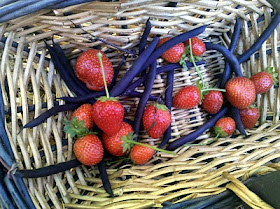We love playing with tangrams! The
Magnetic Travel Tangoes - Animals
set we have is great, but I thought it would be fun to have a larger set to play with as well so we made some!
What you need:
- large piece of cardboard (shirt/cereal box)
- ruler
- pencil
- scissors
Optional items:
- printer
- clear contact paper
- foam paper/felt
- hole punch
- sting/yarn
The instructions for making your own set can be found
here. I doubled the scale on my set, and used an old shirt box.
1. Break open the shirt box and trim the edges off.
2. Start drawing your grid.
3. Complete the grid to make it 4x4, trim off the excess, and follow the pattern from the link above or copy mine below. Each of my squares are 2" x 2", for reference.
4. Before you cut, if you'd like the pieces to be a little more robust, put contact paper on the side you didn't draw on, and trim off the excess.
5. Cut your shapes! You'll want to either draw your cutting lines darker than mine or pay close attention to the cuts.
6. The rhombus is the only asymmetric piece so I cut a matching piece out to glue onto the back, since you need to flip it over for certain puzzles.
You can play with your tangram pieces now! Beyond this point is optional!
7. I suggest sticking with either your own creations or solutions to the puzzles at first. Tangrams can be very challenging so if you print out silhouettes, try them first just to see how difficult they can be! Here are a few (found by Google image searching "tangram solutions"):
Animals
Birds
Boats
Buildings
Fish
People
Silhouettes like this are also available.
I printed out several:
8. I then popped them into a book with foam paper (felt or cardboard work as well) by cutting two pieces of foam slightly larger than the solutions...
9....and used my favorite hole puncher and string to finish it off:
10. Now you can make fun things like a rabbit (this is actually a different one than the one above):
11. Or you can have a mismatched pajama party and make a house:
To take this a step even further, add magnets on the back of the shape pieces and it's a fun refrigerator game. You can also add a pocket to the inside of your book and you have a set of travel tangrams for your next long trip (though you might want to make a smaller set for that!).






















